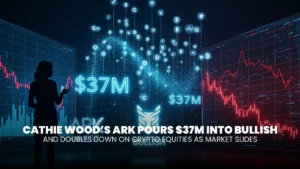TRON Takes the Lead as US Economic Data Makes Debut on Public Blockchains

For the first time in US history, official GDP numbers have been published directly onto public blockchains. The Q2 2025 GDP release was uploaded to TRON, a blockchain that utilizes Delegated Proof of Stake (DPoS) to handle millions of transactions in a short amount of time at low costs.
- Government Blockchain Pilot Expands Transparency
- A Real-Time Event With Market Impact
- Fee Cuts and Adoption Growth Shape the Timing
- Social Media Buzz
- Key Numbers From the Event
- How TRON’s Consensus Model Kept the Network Stable
- Market Reactions
- Broader Implications
- Conclusion
- Frequently Asked Questions About TRON GDP Data
- What exactly did the US Commerce Department do?
- Why was TRX chosen?
- What is Delegated Proof of Stake (DPoS)?
- How did TRON’s network perform?
- Did TRX price move on the news?
- Which other blockchains were included?
- What risks does TRX face?
- Does this mean the government endorses TRX?
- What could come next?
- How does this tie into US and EU regulations?
- Glossary of Key Terms
According to the Bureau of Economic Analysis, the growth rate of the quarter stood at 3.3 percent on an annualized basis. With the standard press release, the agency also uploaded a cryptographic hash of the data file onto the network of TRON. It is a hash that performs as a digital fingerprint. Any person can now confirm that the release of GDP that is circulating online is the same as that which is officially issued by the government.
This is the first occasion that TRON is used in a high profile role. The event demonstrates how blockchains such as TRON can introduce transparency and accountability into how governments share information with the public.
Government Blockchain Pilot Expands Transparency
The GDP release on TRON was not an isolated move. The US Department of Commerce pushed the same data hash to eight other blockchains: Bitcoin, Ethereum, Solana, Polygon, Avalanche, Stellar, Arbitrum, and Optimism. By spreading the data across multiple networks, the government ensured redundancy and widened the reach of verifiable economic information.
This multi-chain approach shows that officials are not betting on a single protocol. Instead, they are testing how different architectures behave under the same conditions. With GDP data anchored across blockchains, tampering becomes nearly impossible and verification becomes simple for anyone, anywhere.
Infrastructure providers also played a role. Oracles such as Chainlink and Pyth helped move the official data from government systems to blockchains. Their involvement highlights that the pilot is about reliability as much as visibility.
A Real-Time Event With Market Impact
The moment the GDP hash went live on TRON, activity on the network spiked. Daily settlements reached more than $22 billion, with nearly 9 million transactions confirmed. Analysts noted that TRON’s recent 60 % energy-fee cut allowed the network to handle the surge without raising costs for users.
In simple terms, TRON’s DPoS system and lower fees worked together like a stress test: millions of people were watching, billions of dollars were moving, and the chain stayed smooth.
Crypto dashboards lit up with traffic reports. Commentators compared it to a financial “stress rehearsal” where TRON showed it could support not just stablecoin payments and DeFi activity, but also government-level data publishing.
Fee Cuts and Adoption Growth Shape the Timing
TRON’s selection came just weeks after its community approved a 60% cut in energy fees, the largest reduction since launch. The change immediately lowered costs for users, driving daily active addresses above 2.5 million.
At the same time, TRON was already handling more than $22 billion in daily settlements and nearly 9 million transactions. The fee cut made the network cheaper to use, while the GDP event showcased its ability to scale under pressure. Together, these factors positioned TRON as one of the strongest candidates for government-level data publication.
ALSO READ: Grayscale Submits Amended S-1 For Cardano ETF To NYSE Arca As Approval Odds Hit 87%
Social Media Buzz
The announcement quickly spread on social media. TRON’s founder, Justin Sun, posted the news:
https://publish.twitter.com/?url=https://twitter.com/justinsuntron/status/1962339309090160845#
Community accounts echoed the excitement. One observer wrote:
https://twitter.com/DeFi_JUST/status/1962365774435398016
These posts captured the mood: pride inside the TRON ecosystem, curiosity from the wider market, and cautious recognition from analysts that government attention was shifting toward blockchain infrastructure.
Key Numbers From the Event
| Metric / Detail | Value / Status |
| US Q2 2025 GDP growth | 3.3 percent annualized |
| Transaction hash (GDP release) | 3f05633fb894aa6d6610c980975cca732a051edbbf5d8667799782cf2ae04040 |
| Daily settlements on TRON | Over $22 billion |
| Daily transactions | About 9 million |
| Daily active users (after fee cut) | More than 2.5 million |
| Energy fee reduction | 60 percent (August 2025) |
How TRON’s Consensus Model Kept the Network Stable
Instead of every user trying to validate blocks, TRON allows token holders to elect a small set of Super Representatives who produce and confirm blocks on behalf of the network. This governance model keeps the system fast and affordable.
During the GDP release, this consensus structure kept the chain stable under global attention. TRON processed millions of transactions with ease, and the fee reduction made sure costs stayed low for end users.
Supporters say the event proved TRON’s model is not just technical detail but practical infrastructure for real-world applications. Critics continue to ask whether lower fees will affect validator incentives, but the live demonstration was a strong performance under pressure.
Market Reactions
TRON’s native token TRX traded around $0.34 in the days following the announcement. While the price reaction was moderate, analysts noted that adoption signals like this often matter more for long-term confidence than short-term price jumps.
More significant were the usage numbers: over 2.5 million daily active users, beating out networks like Solana and BNB Chain. For traders, this suggests TRON is not only holding its ground but expanding its lead in active user metrics.
Market commentary also focused on the balance between fees and revenue. By cutting fees 60 percent, TRON accepted a short-term revenue dip but gained higher user activity and potentially deeper market share.
ALSO READ: 21Shares Files For SEI ETF with Staking Option as SEC Considers Altcoin Approvals
Broader Implications
The US government’s step into blockchain publishing does not mean it endorses any token. But it does mean officials see value in public, verifiable systems for distributing information.
For TRON, the implications are wide-ranging:
- Reputation boost. Being in the same category as Bitcoin and Ethereum in a government pilot elevates TRON’s standing.
- Enterprise interest. Companies may now look at TRON as infrastructure for publishing other data beyond payments.
- Future adoption. If GDP data works well, other government datasets—like employment statistics or inflation reports, could follow.
For the blockchain industry more broadly, this event proves that public networks can host official, high-profile information without disruption.
Conclusion
The US Department of Commerce’s choice to publish GDP data on TRX network has transformed a routine economic release into a landmark blockchain event. Backed by a 60 % fee cut and a high-throughput delegated proof of stake consensus model, TRX showed it could handle government-level attention while processing billions in daily settlements.
For now, TRON has gained recognition, visibility, and a surge in users. The longer-term outcome will depend on whether this pilot expands into ongoing adoption. What is clear is that TRX has passed a real-world test and its model of low-cost, scalable consensus is now proven infrastructure for public transparency.
Frequently Asked Questions About TRON GDP Data
What exactly did the US Commerce Department do?
It recorded a cryptographic hash of the Q2 2025 GDP release on TRON, making the data verifiable.
Why was TRX chosen?
Because of its low fees, high throughput, and wide adoption in stablecoin transfers.
What is Delegated Proof of Stake (DPoS)?
A consensus model where token holders elect a small number of block producers, who confirm transactions on behalf of the network.
How did TRON’s network perform?
It processed nearly 9 million transactions and more than $22 billion in settlements while daily active users rose to over 2.5 million.
Did TRX price move on the news?
TRX traded around $0.34, with moderate price action but strong adoption signals.
Which other blockchains were included?
Bitcoin, Ethereum, Solana, Polygon, Avalanche, Stellar, Arbitrum, and Optimism.
What risks does TRX face?
Maintaining validator incentives under lower fees and sustaining activity after the initial spike.
Does this mean the government endorses TRX?
No. The pilot focused on transparency, not on promoting tokens.
What could come next?
Other datasets, like inflation or jobs numbers, could be published the same way.
How does this tie into US and EU regulations?
In the US, the GENIUS Act sets stablecoin rules, while Europe’s MiCA standardizes digital assets. TRX’s GDP role shows blockchains can meet transparency and compliance needs.
Glossary of Key Terms
- Blockchain – A digital ledger where transactions are recorded permanently and publicly.
- Hash – A unique digital fingerprint that proves data integrity.
- Delegated Proof of Stake (DPoS) – A consensus system where token holders elect block producers to validate transactions.
- TRX – The native token of the TRON blockchain.
- Stablecoin – A cryptocurrency pegged to a stable asset like the US dollar.
- Validator – A participant responsible for securing the blockchain and confirming blocks.
- Throughput – The number of transactions a blockchain can process per second.
- Settlement Volume – The total dollar value of transactions processed daily on a network.
- Oracle – A service that feeds real-world data into blockchains.
- Active Users – The number of people interacting with a blockchain within a set time period.




